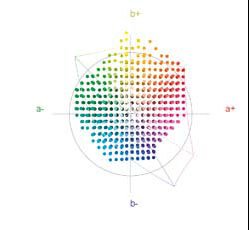articles/Printers/epsonrstuylusprok3-page2
Epson Stylus Pro UltraChrome K3 Printers - part 2 of 1 2 3 4 5 6 7 8 9 10
by Mike McNamee Published

Printing Times The printing times given in the brochure are measured in m2/h at draft quality, not the most user friendly way of expressing printer speed. Here is what we found printing real images, at the high quality the 4800 is capable of:
Profiles Printers are only as good as the profiles that drive them. Epson has made great strides in both the consistency of their large format colour and the driver profiles over the past number of years. The 4800 we installed came with 27 profiles, dated November 04, each with a size of 741Kb. Recently Epson America posted new profiles made with X-Rite equipment, dated April 05 and weighing in at 1.62Mb. This would suggest that Epson has increased the bit depth of the profile by using more patches to make it. There are nine profiles for the 4800 and nine for the 7800/9800 (they are different!) and prefixed by the letters "SP" rather than "Pro". They are also specified for the resolution - as they should be - higher resolution means more ink from an Epson driver and this needs to be adjusted for in the profile. The driver we installed was version 1.0. Keep an eye out for changes if you order a machine some time in the future. As part of measuring the colour performance we tested the 4800 using No Profiles (Auto drivers only, employing the Look Up Tables), the two types of icc profile available and a bespoke profile we made ourselves using X-Rite equipment. All the results were audited in the same way as we test in Paper Chase.

Initially, the paper we chose was the discontinued Epson Smooth Fine Art, which was made by Cranes. It is an archival quality media made from 100% cotton rag. There is no longer a Smooth Fine Art setting in the media drop down and so we employed UltraSmooth Fine Art as our setting and the profiles to match this setting. Matte Black ink was installed. We were astounded by the data in the audit analysis. They are tabulated below. We have become used to Epson printers raising the bar but we had to go delving back into the records to find the previous high mark. As far as we can see the previous best was on Tom Lee's Epson 4000 driven by the Ilford Studio RIP which delivered an error of 2.59 ÄE2000 straight from the box onto Pearl paper. The 4800 produced 2.31, but this was for a matte art paper, not a gloss with its higher Dmax. The Dmax for SFA was between 1.45 and 1.50. Our average error, across all machines, hovers around 3.3 DE2000 for bespoke profiling so the results were outstanding. Statistically they lie outside the UltraChrome population of data, representing a genuine step forward. Bear in mind, when reading this, that we are talking the best of the best here, these are fine differences which are only just detectable under ideal conditions. The significant and major drawback of this paper is the tendency for the blacks to have patches of uneven density in solid areas. For this reason alone we have never really liked this paper - maybe Epson felt so when they discontinued the line.
Please Note:
There is more than one page for this Article.
You are currently on page 2
- Epson Stylus Pro UltraChrome K3 Printers page 1
- Epson Stylus Pro UltraChrome K3 Printers page 2
- Epson Stylus Pro UltraChrome K3 Printers page 3
- Epson Stylus Pro UltraChrome K3 Printers page 4
- Epson Stylus Pro UltraChrome K3 Printers page 5
- Epson Stylus Pro UltraChrome K3 Printers page 6
- Epson Stylus Pro UltraChrome K3 Printers page 7
- Epson Stylus Pro UltraChrome K3 Printers page 8
- Epson Stylus Pro UltraChrome K3 Printers page 9
- Epson Stylus Pro UltraChrome K3 Printers page 10
1st Published
last update 09/12/2022 14:53:58
More Printers Articles
There are 36 days to get ready for The Society of Photographers Convention and Trade Show at The Novotel London West, Hammersmith ...
which starts on Wednesday 14th January 2026




